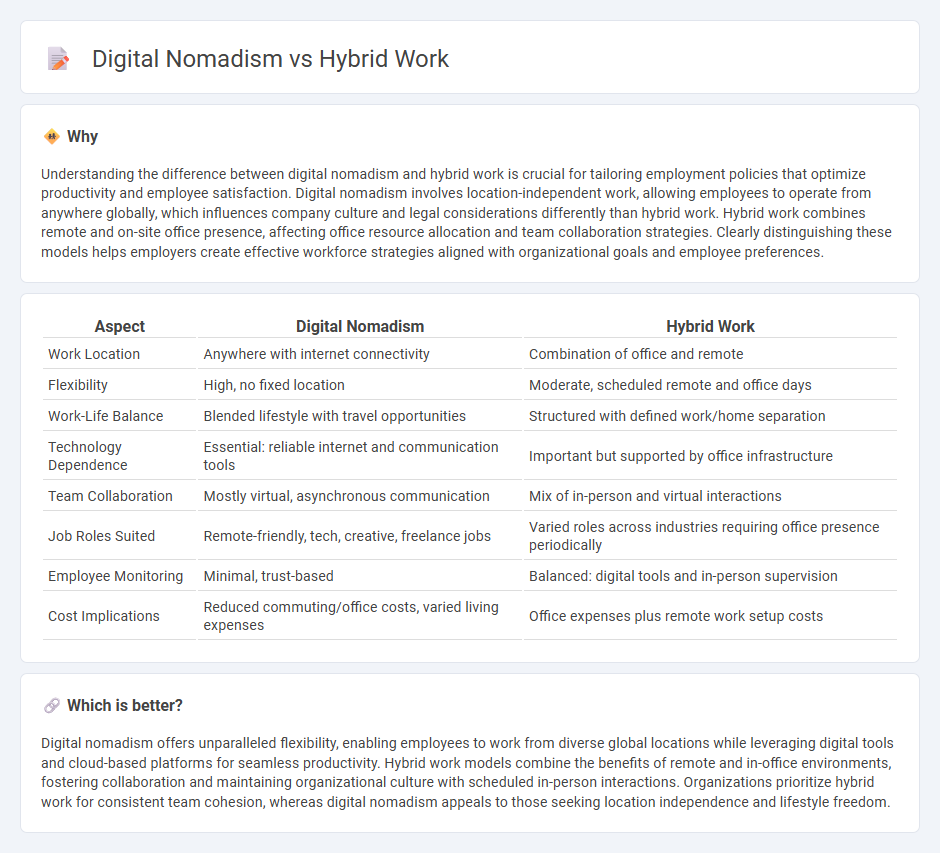
Digital nomadism offers unparalleled flexibility by enabling professionals to work remotely from any location, leveraging digital tools to maintain productivity across time zones. Hybrid work combines remote and in-office environments, providing structured collaboration opportunities alongside remote autonomy. Explore how these evolving employment models shape work-life balance and organizational dynamics.
Why it is important
Understanding the difference between digital nomadism and hybrid work is crucial for tailoring employment policies that optimize productivity and employee satisfaction. Digital nomadism involves location-independent work, allowing employees to operate from anywhere globally, which influences company culture and legal considerations differently than hybrid work. Hybrid work combines remote and on-site office presence, affecting office resource allocation and team collaboration strategies. Clearly distinguishing these models helps employers create effective workforce strategies aligned with organizational goals and employee preferences.
Comparison Table
| Aspect | Digital Nomadism | Hybrid Work |
|---|---|---|
| Work Location | Anywhere with internet connectivity | Combination of office and remote |
| Flexibility | High, no fixed location | Moderate, scheduled remote and office days |
| Work-Life Balance | Blended lifestyle with travel opportunities | Structured with defined work/home separation |
| Technology Dependence | Essential: reliable internet and communication tools | Important but supported by office infrastructure |
| Team Collaboration | Mostly virtual, asynchronous communication | Mix of in-person and virtual interactions |
| Job Roles Suited | Remote-friendly, tech, creative, freelance jobs | Varied roles across industries requiring office presence periodically |
| Employee Monitoring | Minimal, trust-based | Balanced: digital tools and in-person supervision |
| Cost Implications | Reduced commuting/office costs, varied living expenses | Office expenses plus remote work setup costs |
Which is better?
Digital nomadism offers unparalleled flexibility, enabling employees to work from diverse global locations while leveraging digital tools and cloud-based platforms for seamless productivity. Hybrid work models combine the benefits of remote and in-office environments, fostering collaboration and maintaining organizational culture with scheduled in-person interactions. Organizations prioritize hybrid work for consistent team cohesion, whereas digital nomadism appeals to those seeking location independence and lifestyle freedom.
Connection
Digital nomadism and hybrid work share a common foundation in flexible employment models that leverage technology to enable remote productivity across diverse locations. Digital nomads typically engage in full-time remote work while traveling, blending professional tasks with exploration, whereas hybrid work combines in-office presence with remote days to balance collaboration and autonomy. Both trends reflect evolving workforce preferences that emphasize adaptability, work-life integration, and reliance on digital tools like cloud platforms, virtual communication, and project management software.
Key Terms
Flexibility
Hybrid work offers structured flexibility by allowing employees to split time between remote and in-office settings, optimizing productivity and work-life balance. Digital nomadism provides unparalleled freedom, enabling professionals to work from any global location, fostering cultural exploration and adaptability. Explore how these flexible work models can transform your career and lifestyle.
Remote Infrastructure
Hybrid work combines in-office and remote settings, relying on robust remote infrastructure such as VPNs, cloud-based collaboration tools, and secure access points to ensure seamless communication and data protection. Digital nomadism depends heavily on flexible, high-speed internet, mobile hotspots, and global co-working spaces to maintain productivity from various locations worldwide. Explore key remote infrastructure solutions to optimize your work model effectively.
Work-Life Balance
Hybrid work offers a structured balance between in-office collaboration and remote flexibility, enhancing productivity while maintaining personal routines. Digital nomadism prioritizes complete location independence, allowing individuals to blend work with travel, which can both enrich life experiences and challenge consistent work habits. Explore how these approaches redefine work-life balance to find the best fit for your lifestyle.
Source and External Links
What is hybrid work and what are hybrid work models? - Webex - Hybrid work is a flexible work model combining in-office, remote, and mobile work, allowing employees autonomy to choose where and how they work best, with different hybrid models adapted to organizational needs.
What Is Hybrid Work? - Cisco - Hybrid work gained prominence during the COVID-19 pandemic and is valued for increasing flexibility, productivity, inclusion, reducing costs, and promoting sustainability through less commuting and office use.
Hybrid Work: Definition, Tips & Strategies - Qualtrics - Hybrid work involves splitting time between physical workplaces and remote locations, with many employees favoring this model for better mental health, work relationships, and reduced burnout.
 dowidth.com
dowidth.com